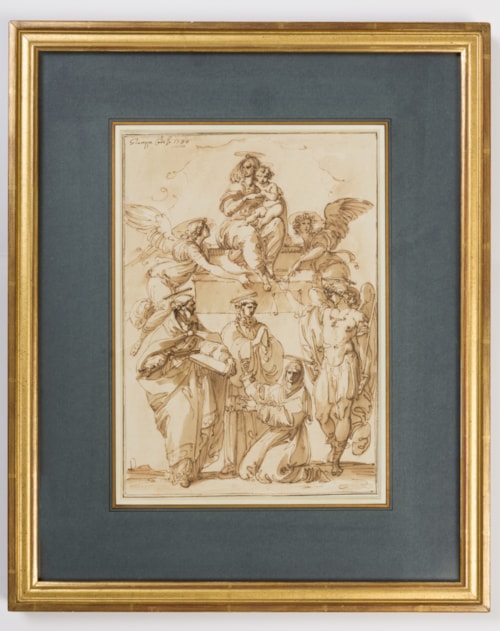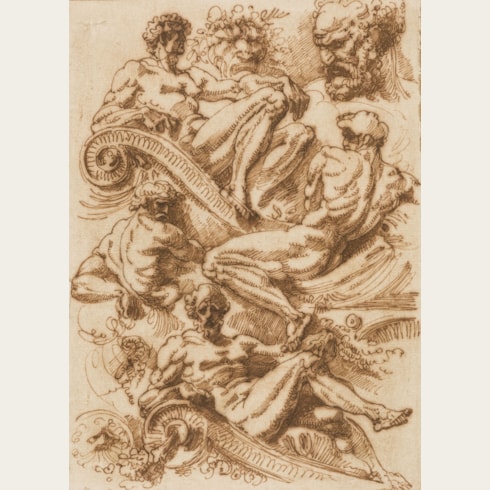Giuseppe CADES
(Rome 1750 - Rome 1799)
The Virgin and Child on a Plinth Supported by Angels, with Saint Michael and other Saints Below
Pen and brown ink and brown wash, with framing lines in brown ink.
Laid down on an early 19th century mount.
Signed and dated Giuseppe Cades f. 1780 at the upper left.
Inscribed Rugby School Art Museum / e dono Matt: H: Bloxam on the mount.
310 x 218 mm. (12 1/4 x 8 1/2 in.)
Laid down on an early 19th century mount.
Signed and dated Giuseppe Cades f. 1780 at the upper left.
Inscribed Rugby School Art Museum / e dono Matt: H: Bloxam on the mount.
310 x 218 mm. (12 1/4 x 8 1/2 in.)
Signed and dated 1780, the present sheet cannot be related to any extant painting by Giuzseppe Cades, although a preparatory sketch by the artist for the same composition, rapidly drawn in pen and ink, is in the collection of the Musée des Tissus et des Arts Décoratifs in Lyon.
This fine drawing can be compared, in stylistic terms, with such works of the same period by Cades as a pen drawing of The Virgin and Child with Two Saints, signed and dated 1779, in the Philadelphia Museum of Art. The comments of the Cades scholar Maria Teresa Caracciolo on the Philadelphia drawing are equally relevant to the present sheet: ‘This sheet clearly shows the evolution of Cades’s style as a draughtsman towards the end of the 1770s: the pen is now his preferred means of defining form with a fine and nervous line, alternating perfect rigour (in the drawing of architecture) with freer and more capricious effects in the hair and drapery. Highlights in a light wash discreetly emphasize the shadows and volumes. The stiffness of line of the adolescent drawings, the exuberance and excesses of modelli based on ancient history now seem to be outdated in favour of a new balance between a classicizing composition and a graphic style still largely dependent on a Mannerist example (Roman and Bolognese), whose firm, supple lines construct elegant and finished forms.’
The present sheet was one of six drawings by or attributed to Giuseppe Cades in the collection of the 19th century antiquary and architectural historian Matthew Holbeche Bloxam (1805-1888), of Rugby in Warwickshire. (Each of the drawings are laid down on identical mounts, and it has been suggested that they may have all been acquired together as a group, possibly from the artist’s studio.) Like his father before him, Bloxam had studied at Rugby School, of which he remained a devoted supporter throughout his life. When the school’s Art Museum opened in 1879, Bloxam began donating individual drawings from his collection to the museum on a yearly basis, often on his birthday.
This fine drawing can be compared, in stylistic terms, with such works of the same period by Cades as a pen drawing of The Virgin and Child with Two Saints, signed and dated 1779, in the Philadelphia Museum of Art. The comments of the Cades scholar Maria Teresa Caracciolo on the Philadelphia drawing are equally relevant to the present sheet: ‘This sheet clearly shows the evolution of Cades’s style as a draughtsman towards the end of the 1770s: the pen is now his preferred means of defining form with a fine and nervous line, alternating perfect rigour (in the drawing of architecture) with freer and more capricious effects in the hair and drapery. Highlights in a light wash discreetly emphasize the shadows and volumes. The stiffness of line of the adolescent drawings, the exuberance and excesses of modelli based on ancient history now seem to be outdated in favour of a new balance between a classicizing composition and a graphic style still largely dependent on a Mannerist example (Roman and Bolognese), whose firm, supple lines construct elegant and finished forms.’
The present sheet was one of six drawings by or attributed to Giuseppe Cades in the collection of the 19th century antiquary and architectural historian Matthew Holbeche Bloxam (1805-1888), of Rugby in Warwickshire. (Each of the drawings are laid down on identical mounts, and it has been suggested that they may have all been acquired together as a group, possibly from the artist’s studio.) Like his father before him, Bloxam had studied at Rugby School, of which he remained a devoted supporter throughout his life. When the school’s Art Museum opened in 1879, Bloxam began donating individual drawings from his collection to the museum on a yearly basis, often on his birthday.
Giuseppe Cades enjoyed a highly successful, albeit relatively brief, career as one of the leading history painters and decorators in Rome in the last quarter of the 18th century. The son of a French tailor who had settled in Rome, he was a pupil of Domenico Corvi at the Accademia di San Luca. Cades was a precocious student with a particular talent for draughtsmanship, and some of his earliest drawings are dated 1762 and 1763, when he was barely a teenager. A few years later, at the age of sixteen, he won the first prize in a drawing competition at the Accademia di San Luca with a very large red chalk drawing of Tobit Curing His Father’s Blindness. Part of his artistic training was to make drawn copies after Renaissance masters, a practice he continued in his maturity. Expelled from Corvi’s studio in 1766 because of his stubborn and independent nature, Cades abandoned formal academic training and gravitated toward the community of French, Scandinavian and German artists then working in Rome - centred around the painters Johan Tobias Sergel and Johann Heinrich (Henry) Fuseli - whose work was to have a strong influence on his own. As the Cades scholar Maria Teresa Caracciolo has noted, ‘It was among these northern artists, outside the academic climate and even at odds with it, that Cades as a young man seems to have become aware of the possibilities open to him through challenging the classical rules and reverting to the Mannerist form, but in a daring and modern way, where quality and intensity of expression were concerned.’
During the first decade of his independent career, between 1770 and 1780, much of Cades’s work took the form of large, highly finished drawings of classical subjects, which he produced as autonomous works of art for sale to collectors. As Caracciolo has pointed out, ‘These drawings demonstrate the new way in which the artist looked at ancient history, conveying it with a theatrical pathos tinged with irony.’ However, the artist soon established a successful career as a painter, earning his first official commission in 1774 with an altarpiece for a church in Piedmont, while his first significant work in Rome was an altarpiece of The Ecstasy of Saint Joseph of Cupertino in the church of Santi Apostoli, painted in 1777. Cades’s later religious works included numerous altarpieces commissioned for churches in Rome and elsewhere in Italy, particularly in the late 1780s and 1790s; among the most important of these were five large paintings for the monastery of San Francesco in Fabriano, painted between 1787 and 1790. Cades was also in great demand as a decorative history painter, and among his important public commissions was the decoration of the Sala di Musica of the Palazzo Senatorio in 1779, executed in collaboration with the architect Giacomo Quarenghi. He worked in several Roman palaces, notably the Villa Borghese, the Palazzo Altieri and the Palazzo Ruspoli, as well as at the Palazzo Chigi in Ariccia.
Giuseppe Cades was among the most gifted and distinctive artists of the period; as Caracciolo has noted, ‘His paintings and drawings, which could vary in style from the baroque to the neoclassical, often appear to be fifty years ahead of their time in their quality of historical revivalism.’ He served a term as director of the Accademia del Nudo, the drawing academy in Rome founded in 1754. Among his patrons were the Empress Catherine the Great of Russia, and the royal courts of Spain and Portugal. Although he enjoyed a highly successful career, his membership in the Roman Accademia di San Luca was continually blocked by his former teacher Corvi, and it was not until 1786 that he was admitted into the institution. The last decade of his career was much occupied with his participation in the activities of the Accademia. Cades died, still at the height of his powers, at the relatively young age of forty-nine, and is buried in the basilica of Sant’Andrea della Fratte.
Important groups of drawings by Cades are today in the collections of the Museu Nacional de Arte Antiga in Lisbon (which owns an album of 126 drawings by the artist that once belonged to the Portuguese painter Domingos António de Sequeira), the Kupferstichkabinett in Berlin, the Szépmüvészeti Múzeum in Budapest, the Hermitage in St. Petersburg and the Philadelphia Museum of Art.
During the first decade of his independent career, between 1770 and 1780, much of Cades’s work took the form of large, highly finished drawings of classical subjects, which he produced as autonomous works of art for sale to collectors. As Caracciolo has pointed out, ‘These drawings demonstrate the new way in which the artist looked at ancient history, conveying it with a theatrical pathos tinged with irony.’ However, the artist soon established a successful career as a painter, earning his first official commission in 1774 with an altarpiece for a church in Piedmont, while his first significant work in Rome was an altarpiece of The Ecstasy of Saint Joseph of Cupertino in the church of Santi Apostoli, painted in 1777. Cades’s later religious works included numerous altarpieces commissioned for churches in Rome and elsewhere in Italy, particularly in the late 1780s and 1790s; among the most important of these were five large paintings for the monastery of San Francesco in Fabriano, painted between 1787 and 1790. Cades was also in great demand as a decorative history painter, and among his important public commissions was the decoration of the Sala di Musica of the Palazzo Senatorio in 1779, executed in collaboration with the architect Giacomo Quarenghi. He worked in several Roman palaces, notably the Villa Borghese, the Palazzo Altieri and the Palazzo Ruspoli, as well as at the Palazzo Chigi in Ariccia.
Giuseppe Cades was among the most gifted and distinctive artists of the period; as Caracciolo has noted, ‘His paintings and drawings, which could vary in style from the baroque to the neoclassical, often appear to be fifty years ahead of their time in their quality of historical revivalism.’ He served a term as director of the Accademia del Nudo, the drawing academy in Rome founded in 1754. Among his patrons were the Empress Catherine the Great of Russia, and the royal courts of Spain and Portugal. Although he enjoyed a highly successful career, his membership in the Roman Accademia di San Luca was continually blocked by his former teacher Corvi, and it was not until 1786 that he was admitted into the institution. The last decade of his career was much occupied with his participation in the activities of the Accademia. Cades died, still at the height of his powers, at the relatively young age of forty-nine, and is buried in the basilica of Sant’Andrea della Fratte.
Important groups of drawings by Cades are today in the collections of the Museu Nacional de Arte Antiga in Lisbon (which owns an album of 126 drawings by the artist that once belonged to the Portuguese painter Domingos António de Sequeira), the Kupferstichkabinett in Berlin, the Szépmüvészeti Múzeum in Budapest, the Hermitage in St. Petersburg and the Philadelphia Museum of Art.
Provenance
Matthew H. Bloxam, Rugby, Warwickshire
Presented by him to Rugby School, Rugby, Warwickshire, probably between 1879 and 1888.
Presented by him to Rugby School, Rugby, Warwickshire, probably between 1879 and 1888.








